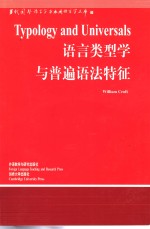
- 作 者:(英)William Croft 沈家煊导读
- 出 版 社:北京:外语教学与研究出版社
- 出版年份:2000
- ISBN:7560019439
- 标注页数:319 页
- PDF页数:347 页
请阅读订购服务说明与试读!
订购服务说明
1、本站所有的书默认都是PDF格式,该格式图书只能阅读和打印,不能再次编辑。
2、除分上下册或者多册的情况下,一般PDF页数一定要大于标注页数才建议下单购买。【本资源347 ≥319页】
图书下载及付费说明
1、所有的电子图书为PDF格式,支持电脑、手机、平板等各类电子设备阅读;可以任意拷贝文件到不同的阅读设备里进行阅读。
2、电子图书在提交订单后一般半小时内处理完成,最晚48小时内处理完成。(非工作日购买会延迟)
3、所有的电子图书都是原书直接扫描方式制作而成。
1 Introduction 1
1.1 Definitions and scope of typology 1
1.2 Cross-linguistic comparison 4
Preface by Halliday 9
王宗炎序 10
1.3 The problem of cross-linguistic comparability 11
导读 13
1.4 Non-typological factors and the sampling problem 18
1.5 Data sources 25
Preface and Acknowledgments 26
2 Typological classification 27
2.1 Introduction 27
2.2 The concept of a linguistic type(strategy) 27
Abbreviations 28
2.3 Morphological typology 39
3 Implicational universals 44
3.1 Restrictions on possible language types 44
3.2 Unrestricted and implicational universals 46
3.3 Deeper explanations for word-order universals 53
4 Markedness in typology 64
4.1 Introduction 64
4.2 Markedness and implicational universals 67
4.3 Criteria for markedness 70
4.3.1 Structure 72
4.3.2 Behavior 77
4.3.2.1 Inflectional behavior 77
4.3.2.2 Distributional behavior 81
4.3.3 Frequency 84
4.3.4 Neutral value 89
4.4 Conclusion 91
5 Grammatical hierarchies 95
5.1 Introduction 95
5.2 Hierarchies,implicational universals and markedness 96
5.3.1 Number 98
5.3 The principalgrammatical luerarchies 98
5.3.2 The grammatical relations hierarchy and NP accessibility 101
5.3.3 Animacy,definiteness and hierarchy of features 111
5.3.4 Bondedness(the modifier hierarchy) 117
5.4 Phonological hierurchies 120
5.5 Conclusion 122
6 Prototypes and the interaction of typological patterns 124
6.1 Introduction 124
6.2 Clusters and typological evidence for prototypes 124
6.2.1 Animacy and definiteness 127
6.2.2 Transitivity 130
6.3.1 Some phonological examples 134
6.3 Markedness reversals and complementary prototypes 134
6.3.2 Case.animacy and verb type 136
6.3.3 Nouns.verbs and adjectives 139
6.3.4 Other markedness reversals 143
6.4 More complex interactions 147
6.4.1 Place of articulation 147
6.4.2 Person 149
6.5 Typology and syntactic analysis 150
7 External motivation and the typology of form-function relations 155
7.1 Introduction 155
7.2.1 Frequency 156
7.2 Markedness and economic motivation 156
7.2.2 Other external explanations for markedness patterns 160
7.3 Iconicity 164
7.3.1 “Isomorphism”and polysemy 165
7.3.2 Iconic motivation 171
7.3.2.1 Conceptual distance and constituent structure 174
7.3.2.2 Syntactic categories.objects and events 183
7.3.2.3 Other universals of linguistic structure 189
7.4 Competing motivations 192
7.5 Typological conspiracies and communicative motivation 197
7.6 Conclusion 202
8.2 The dynamicization of synchronic typology 203
8.1 Introduction 203
8 Diachronic typology 203
8.3 From states to processes 218
8.4 Directionality of change 227
8.5 Grammuticalization 230
8.5.1 Correlated grammuticalization processes 230
8.5.1.1 Phonological 231
8.5.1.2 Morphosyntactic 233
8.5.1.3 Functional 236
8.5.2 Some issues in grummaticalization 240
8.6 Conclusion 244
9.1 Introduction 246
9 Linguistic explanation in the dynamic paradigm 246
9.2 Description.explanation and generalization 247
9.3 Internal generalizations:language-internal and cross-linguistic 249
9.4 External generalizations:language and biology 252
9.5 Diachronic explanations and synchronic grammar 256
Notes 260
Peferences 278
Map of languages cited 293
Auth or index 301
Language index 304
Subjectindex 307
Croft:Typology and Universals:Errata 312
文库索引 315
